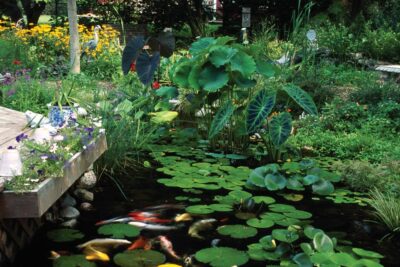Glacial remnants, rivers blocked by glaciers, and rivers that fill natural basins form lakes and ponds.
During the drying process of lakes and ponds, inland wetlands form. Throughout the soil there are small pockets of still or slow-moving water, and the soil is supersaturated with water.
A lake, pond, or inland wetland has standing water, not flowing water. Despite swift currents as waters enter and leave lakes and ponds, these bodies generally move slowly due to their blocked nature (by beaver dams, humans, naturally occurring rock cavities, etc.).
There are layers (stratifications) in lakes, ponds, and inland wetlands based on temperature, oxygen, and life forms.
Wetlands, lakes, and ponds all contain mud that contains the decaying bodies of dead plants and animals. There is more mud at the bottom of an older body of water.
There is an abundance of life along the shorelines of lakes, ponds, and wetlands. Fish and crustaceans are nourished in these areas as they are along the ocean coast. Pollutants run off the land and are filtered by the plants here. Ponds and lakes with older littoral zones have a larger edge zone.
The difference between a pond and a lake?
In both cases there is a depression in the ground around an open body of freshwater. An inland lake is usually larger and deeper than a pond. Plants grow from one side of lakes to the other of ponds because of their shallowness. The average depth of a pond is less than six or seven feet. For plants to grow on the bottom of lakes, the middle of the lake is typically too deep for them to have enough sunlight. Typically, the temperature of the water in a pond is the same from top to bottom. The temperature of the air also affects the water’s temperature. Ice can form on the tops and bottoms of ponds in very cold climates

Permanent ponds and temporary ponds are the two types:
Year-round ponds are present. Water accumulates in temporary ponds as a result of melting snow and rain during the springtime. Summer is the driest time for vernal ponds. It is common to find frogs and amphibians breeding in vernal ponds. During the dry season, vernal pond organisms survive.
It has been discovered that some algae and protozoa make lime cysts or hard covers out of the mud to protect themselves! Water when it fills the pond in the spring protects the organisms. Also called vernal pools, vernal ponds have a pond-like shape.
An underground depression is filled by water when it begins to fill up with water. The first plants that grow below the surface of the pond are called pioneer plants. As the pond grows, emergent plants appear on the edge. Plants around ponds begin to die and decompose after growing and dying for a long time. Plants decompose and layers of soil build up, resulting in ponds that become shallower and shallower.
In shallow ponds, the plants on the edge may begin growing in the pond. The pond will become a marsh when this happens. Eventually, trees may grow in marshes once the marsh plants have grown, died, and decomposed. As a result, the marsh has become a swamp. A swamp may dry up over time and become a forest or grassland! It takes hundreds of years for all this to happen!
The ageing process of lakes and ponds (succession)
As animals and plants age, so do ponds and lakes. Dead material fills up lakes and ponds over time, which forms wetlands as they dry up. It has been estimated that ponds can live for 100 years on average, though human impact tends to accelerate this process.
A lake or pond’s bottom becomes contaminated with organic matter as it ages. During eutrophication, the organic matter gradually consumes all the oxygen in the water. Lakes and ponds older than a century develop swamp-like characteristics and produce methane.
Bioindicators can be used to determine the age of a lake or pond. The type of phytoplankton (microscopic platforms) and algae in a pond or lake is a good indicator of its age.

Characteristics of Stagnate Ponds
Poor water aeration is the most common cause of bad pond odor, which usually smells like rotten eggs. Ponds need movement of water in order to prevent stagnation. By aerating a pond, you provide oxygen, nutrients, and water circulation, which helps prevent a buildup of substances in one part of the pond. The smell of rotten eggs is emitted by stagnant ponds, and is most noticeable during Spring as temperatures and weather change and water begins to circulate naturally.
Characteristics of Fish Ponds
A fish pond can have many different features and structures, but these are the most important ones in general:
- Dikes or walls around the pond that keep the water from evaporating;
- The canals or pipes through which water enters or leaves ponds;
- Pumps that control the flow of water through a pond; Water controls that regulate the level of water in the pond;
- There are tracks and roads along the pond wall, providing access to the pond;
- Water and fish management equipment, including harvesting facilities.
Characteristics of Waste Stabilization Ponds
Wastewater Stabilization Ponds (WSPs) are large, man-made reservoirs for the disposal of wastewater. These ponds treat blackwater, greywater, and feces through natural processes such as light, wind, microorganisms, and algae. A series of ponds can be used for better treatment, or the ponds can be used individually.
Ponds can be classified as follows:
Anaerobic microorganisms
Facultative
There are several different types of aerobic (maturation), each with its own treatment characteristics.
Keeping WSPs in good condition and maintaining BOD, as well as eliminating pathogens, are low-cost activities. Expertise is required to design large surfaces. Despite still containing nutrients (e.g. N and P), the effluent is highly suitable for reusing in agricultural activities but not for direct reuse in surface waters.










